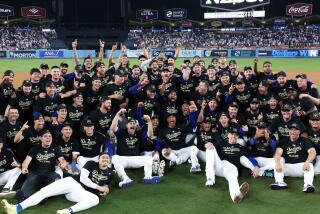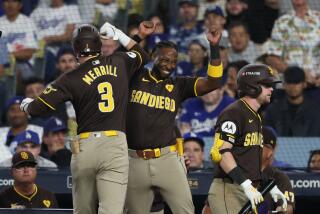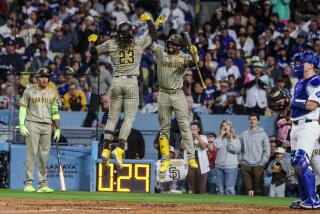Nothing Raw About Padres’ McGriff
Ask a baseball fan to describe a slugger, and he probably would come up with legs like tree trunks, arms like a stevedore’s, a neck like a bull elephant’s, a jaw like Tank McNamara’s and hands like hams.
In his mind, he would be seeing Babe Ruth and Mickey Mantle and Harmon Killebrew and Ted Kluszewski and Jimmy Foxx. The Cincinnati Reds went to sleeveless uniforms when Big Klu was playing because his arms wouldn’t fit into the sleeves they had.
Put a slugger on a football field, and he would be a linebacker. Put him on a golf course, and he would hit the ball so far he couldn’t keep it in the same county, much less same fairway.
A slugger would talk in one syllable words, providing, of course, he could talk at all. Maybe “grunt” would be more like it.
Should that same fan come upon one Frederick Stanley McGriff, he would presume the fellow to be one of those line drive hitters who slashes the ball into gaps and legs out 30 or so doubles a year.
He stands a ramrod straight 6 feet, 3 inches tall, weighs 215 pounds and has a smile that would brighten June . . . the whole month. He has an easy-going, good-natured personality. He should be pushing an ice cream cart.
Fred McGriff doesn’t look like what he is, which is one of the most feared sluggers in the game of baseball.
The key to McGriff is that there is nothing raw about his power. He doesn’t muscle and groan the ball over the fence. He finesses it. His power is refined rather than raw.
Not that he needed to catch anyone’s eye, he did it anyway this week when he hit grand slam home runs in consecutive games. That has happened four times in National League history.
“People ask me how I feel about it,” he said, “and I say it feels good. What can I say? I can’t really come up with anything off the wall.”
Off the wall isn’t McGriff’s style, not conversationally anyway. Put a bat in his hands, and off the wall and over the wall both apply.
He came to the major leagues in 1987 with the Toronto Blue Jays and hit 20 home runs in 295 at bats. Given full-time duty in 1988, he proceeded to run off 34, 36 and 35 home runs over the next three seasons. No one else in the major leagues could match his 106 for that period. No way, Jose.
It was astonishing during the off-season when the Padres were actually criticized for trading Roberto Alomar and Joe Carter for Tony Fernandez and McGriff. Having played in both the wrong league and a different country, McGriff must have been a bit of a secret.
With 25 home runs, McGriff is on target for another 30-homer season. Padre fans are no longer asking why they went out and got this guy. They are just thankful he’s here.
The Padres are also thankful he is here. They have taken to calling him The Natural.
However, Fred McGriff has news for everyone. That swing may look so sweet and easy, but there’s nothing natural about it.
It has to do with hard work, patience and education.
Education?
“I haven’t always been a home run hitter,” he said. “For one thing, there’s a lot of practice time when I work on things. And I read books, study videos and watch other guys hit. I try things to see if they work. You can’t be afraid to fail.”
And what might be his reading material of choice.
“Everybody reads Ted Williams,” he said, “and Charlie Lau, too.”
And there’s nothing seasonal about his approach to hitting. He is not one of those guys who disappears onto a golf course or a lake for the winter months.
“I try to hit as much as I can,” he said. “Even in the off-season, I hit every day. The more you hit, the better you get.”
He lives in Tampa, where he and the New York Mets’ Dave Magadan take turns pitching to each other. It sounds like Tampa would be a good place to have the baseball concession.
Indeed, this self-taught slugger has a way of making baseballs disappear.
Not that he tries.
“You can’t swing hard trying to hit home runs,” he said. “If swinging hard was the secret, everybody would swing hard. This can be a humbling game and you do something different, like trying to swing too hard, and it can mess you up for a week or two.”
The guys who do it with brute strength, the prototypical sluggers, may be able to get away with muscling the ball over the fence, but Fred McGriff has to have his mechanics in order to get the job done. The swing cannot be rushed.
“You can’t be anxious,” he said. “You’ve really got to be patient. The pitcher’s trying to get you to swing at bad pitches. You just want to wait for your pitch and drive it hard. If it goes over the fence, great . . . but a single or double are fine too.”
A key to McGriff’s success is men on base. If the guys ahead of him get on base, the pitcher’s options are narrowed. If no one is on base, he is likely to see pitches around his eyebrows or ankles or both.
And so it came to pass that he twice came to the plate with the bases loaded this week. This was an ideal situation for a cleanup hitter. You cannot pitch around a guy, any guy, with the bases loaded.
You don’t want to walk a batter with the bases loaded, do you?
Maybe it might be a good idea with Fred McGriff.
More to Read
Go beyond the scoreboard
Get the latest on L.A.'s teams in the daily Sports Report newsletter.
You may occasionally receive promotional content from the Los Angeles Times.










